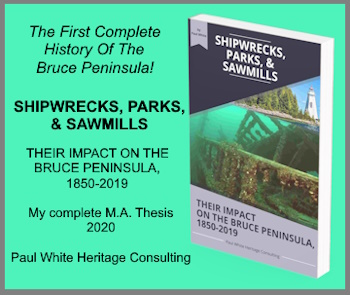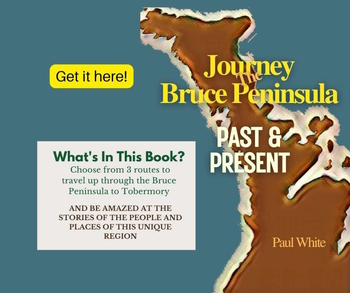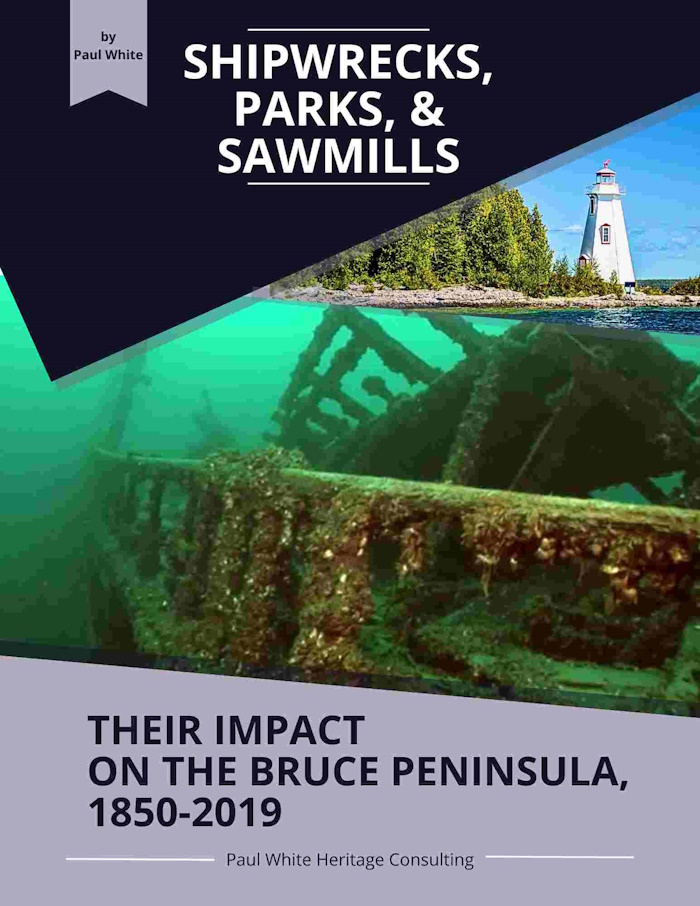Amabel Township Land Auction
The land auction in Amabel Township provided the opportunity for settlers to purchase land and begin a new life in Bruce County in the 1850s.
Shortly after July 18, 1856, a public notice was displayed in Owen Sound and the surrounding area. This auction which would have a large impact on my family.
The notice, signed by R.T. Pennefather, superintendent general of what was called the Indian Department, announced the forthcoming public auction sale of 144,000 acres of land in the new townships of Amabel in Bruce County and Keppel in Grey County.
The farm lands were to be auctioned in 100-acre parcels. Unlike other regions which had been put to public auction, there were few restrictions placed on prospective buyers except those who purchased land which fronted on the "line of road laid out from Sydenham (Owen Sound) to Saugeen." They were required to "cut and remove all the timber from the centre of the road to a depth of ninety feet within one year of the purchase.
The terms of the sale required one-third of the purchase price be paid on the date of sale with the remainder due in six annual equal payments with an interest rate of 6 per cent per year.
It must have been known that there were people already living in the area on land which they did not own because the notice also stated "the Department reserves to itself the power to attach to any lot, at the time of sale, the obligation on the part of the purchaser to pay for any improvements which may have been made on such lot by squatters."
At 10 a.m. on Tuesday, Sept. 2, 1856, prospective buyers waited impatiently for the land auction to begin. Of particular importance to my family, my great, great uncle David Forsyth was among those waiting to buy land.
David and his wife Jane had arrived in the area in 1855 and worked the land which they purchased a year later at the auction — Lot 22, Concession "A" in Amabel Township.
In 1857, Jane gave birth to a daughter, Victoria, who was perhaps the first non-native child born in Amabel Township.
In 1861, David's brother, my great great grandfather Robert John Forsyth, and his wife Alice arrived in Amabel Township and took up the northeast quarter of Lot 22, Concession A. Seven years later, in 1868, Robert and Alice purchased the north half of Lot 21 Concession A.
In 1863, Robert and Alice had their second child, a son, Robert Jones Forsyth. Robert Jr. would marry Mary Anne Thompson and together they had nine children including, in 1899, my grandmother Nellie Forsyth Rowe.
My great grandparents remained on the family homestead until the late 1920s, when they moved to Allenford.
The Amabel Township land auction in Owen Sound in September 1856, proved to be a turning point in my family's history, as it was for many other families whose ancestors lined up at the land auction that day with my great, great, uncle David Forsyth.
The information used in this article came from documents in the Bruce County Museum and Archives, Green Meadows and Golden Sands; The History of Amabel Township and from Marion Taylor, the Forsyth family historian.
For more information about the history of the Bruce Peninsula please check out my book Journey the Bruce Peninsula Past & Present a great travel companion as you travel this unique part of Canada's Great Lakes region.
Bruce Peninsula Towns & Villages
Towns & Villages: The first Bruce Peninsula towns and villages had a source of water power to run sawmills and a good harbour to ship forestry products to market.
The 12th of July and Dominion Day Celebrations on the Bruce Peninsula were an outlet from the everyday drudgery of life for pioneers on the Bruce Peninsula.
Allenford United Church history details some important information about that community's church but also about one of the founders of this Ontario community.
A Pioneer Community: Driftwood Crossing (now Allenford): at the southern-most part of the Saugeen/Bruce Peninsula was at the midpoint between the Georgian Bay and Lake Huron coasts.
Land Auction in Amabel Township provided the opportunity for settlers to purchase land and begin a new life in Bruce County. On July 18, 1856, a notice signed by R.T. Pennefather, superintendent general the Indian Department, announced the public auction sale of 144,000 acres of land in the new townships of Amabel and Keppel.
Barrow Bay Ontario: a Picturesque Georgian Bay Community owes its origin to the once-thriving Bruce Peninsula lumbering industry. Today it is a quiet summer get-away!
Bruce Peninsula Municipal Politics: No matter what the venue, or the issue, seldom is a decision made that suits everyone.
Bruce Peninsula Newspapers Rivalry between the Wiarton Echo and Owen Sound newspapers promoting their communities was often vitriolic and led to acrimony between the two communities.
Dyer's Bay Ontario: Began as a lumbering settlement but may also have been one of the earliest points on the Bruce Peninsula to be visited by French explorers.
Elsinore Ontario: In the mid-1850s the first settlers arrived in the area just west of Allenford. However, it was not until 1865 when the North Gravel Road, or Highway 21 as it known today, was built that the village of Elsinore was established.
Hepworth Ontario: The early history of Hepworth is tied to two essential commodities, sawmilling and transportation. How Hepworth got its name is also an interesting story.
Lion's Head remained an important lumbering centre into the twentieth century. Today it is a centre of tourism, and the lion's head still guards the southern entrance to the bay. However, the same elements that created the image have continued to erode the rocky outcropping.
Park Head was an important Grand Trunk Railway depot on the Bruce Peninsula.
Sauble Beach: This popular beach in the 1950s was called Canada's Daytona Beach.
Sauble Beach Ontario is one of the most popular summer resorts in the province of Ontario. It welcomed its first summer visitors in the late 1800s and as continued to grow in popularity since that time.
Stokes Bay welcomed fishermen as their first non-native visitors. Today, if you are a fisherman, you will also probably want to try your luck landing a walleye, lake trout or any of the other game fish that live in the coastal waters of Lake Huron.
Tobermory Ontario has a rich history and, is the northern- most destination point for travellers visiting the world famous Bruce Peninsula.
Tobermory Ontario Tourism is focused on Fathom Five National Marine Park, Bruce Peninsula National Park, and, shipwreck diving which has become so popular that tourism has become an important part of that community's economy.
Tobermory Pioneers were first the fishermen who came to reap the rewards of the fishing-rich waters at the top of the peninsula.
Tupper Murray was one of the first names given to the community at the top of the Bruce Peninsula
Wiarton Ontario was known for its excellent natural harbour. It seemed to be a natural choice for the location of a port community. Colpoys Bay offered a natural harbour refuge for sailing vessels from storms on the often-tumultuous waters of Georgian Bay. As well, the harbour was located at the portage route across the base of the Bruce ...
Wiarton had Ambitions to Succeed but while success brought them a railroad and other ventures, one attempt did not have a sweet ending for many in the town.
Wiarton News: 1897 Town Council Report. By 1897 Wiarton was an established community and was experiencing some of the growing pains consistent with a community which was constantly expanding its physical borders. A November 1897 Wiarton council meeting reveals some the problems which that community was facing.
Wiarton Beet Industry: Wiarton's Sweet Enterprise Turns Sour! In their attempts to diversify Wiarton's economic base, a dramatic new industry was incorporated in 1896. Originally called the Owen Sound Sugar Manufacturing Company, the Wiarton Beet Sugar Manufacturing Company looked like it would have a large impact on the economy of the Wiarton area.
Wiarton Ontario's First Newspaper: The Echo viewed itself not only as a messenger of the news of the day, but also as a medium to promote the development of the interests of the Bruce Peninsula, and more particularly those of Wiarton.





